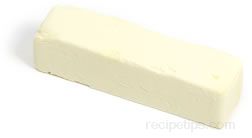Produced from vegetable oils such as soybean and corn, Margarine is a cholesterol free fat. In order to produce margarine in a solid form, the vegetable oil must undergo hydrogenation, which is a process that adds extra hydrogen to the oils. This process changes the chemical composition of the vegetable oils resulting in the oils becoming a solid at room temperature. The hydrogenation process also produces trans-fatty acids (trans fats), which converts the healthy unsaturated fats of the vegetable oils (polyunsaturated and monounsaturated) into solid saturated fats. This characteristic makes many of the margarines on the market no better or worse than butter in terms of nutrition and health. When shopping for margarine, look for brands that are low in trans-fatty acids. Typically, if the texture of the Margarine is harder or more solid such as a "stick" form, it will contain greater amounts of trans fats than softer Margarines sold as spreads in plastic tubs.
Margarine is much more spreadable than butter when used directly from the refrigerator so it is much easier to use on soft breads and rolls. It has a lower smoke point than many cooking oils and fats, so it is usually not the first choice for sautéing or frying.
There are several other varieties of margarine commonly available including soft margarine, whipped margarine, liquid margarine, reduced fat margarine, and fat-free margarine. Soft margarine is formulated to be very easy to spread as is whipped margarine, however so much air is beaten into whipped margarine that as much as half the volume is composed of air. Liquid margarine is packaged in a squeezable bottle, making it easy to use as a condiment for such foods as corn on the cob. It is also convenient to use as a basting medium. Reduced fat margarine has as much as 65% less fat than regular margarine making it a healthier alternative, however because of the high water content, it is not as suitable for some baked goods as regular margarine and it isn't as useful for sautéing or frying. Fat-free margarine is a much healthier spread than regular margarine when used as a condiment. It has a much higher water content than regular margarine so it should not be used for sautéing, frying, or baking.
Margarine should be stored in the refrigerator where it will keep for 2 months or more and for long term storage, it may be kept in the freezer for a half year or longer. Like butter and other solid fats, margarine will absorb the flavors and odors of other foods, so it should be tightly wrapped or covered when storing.








